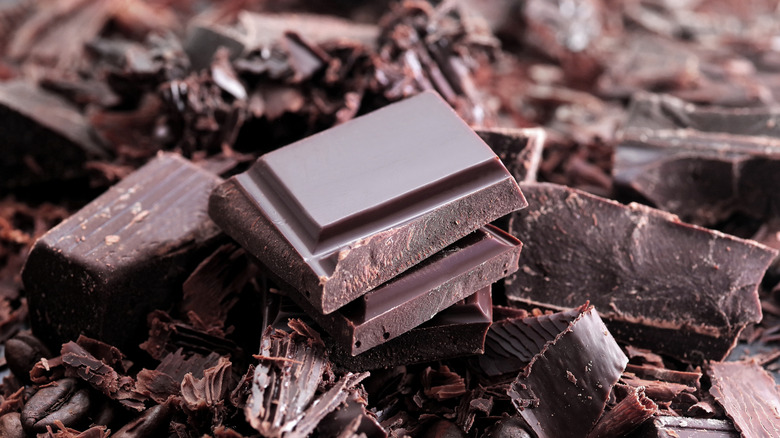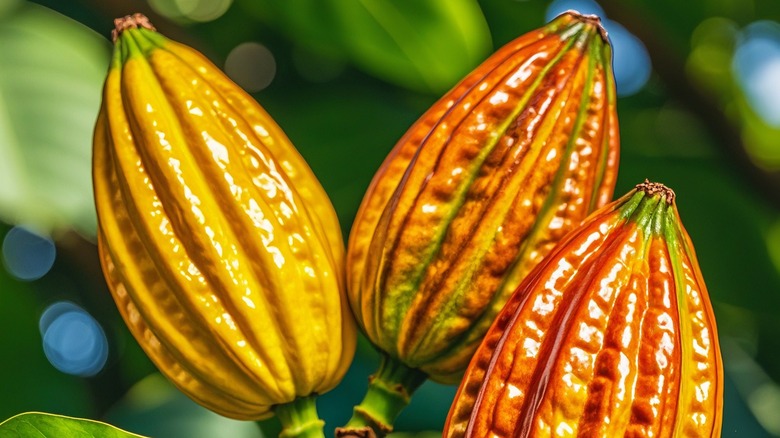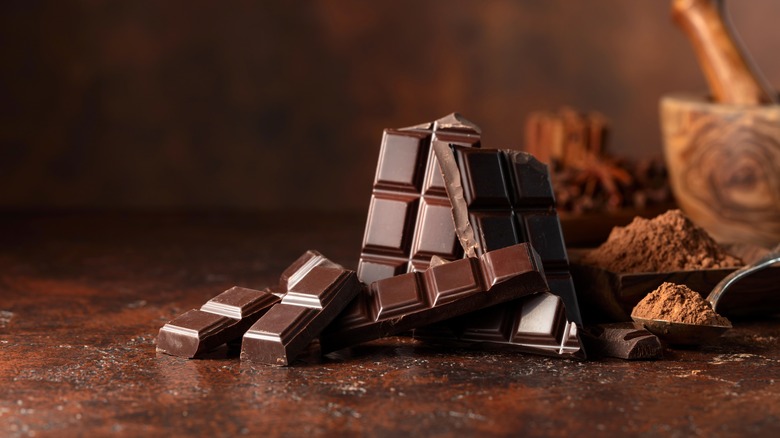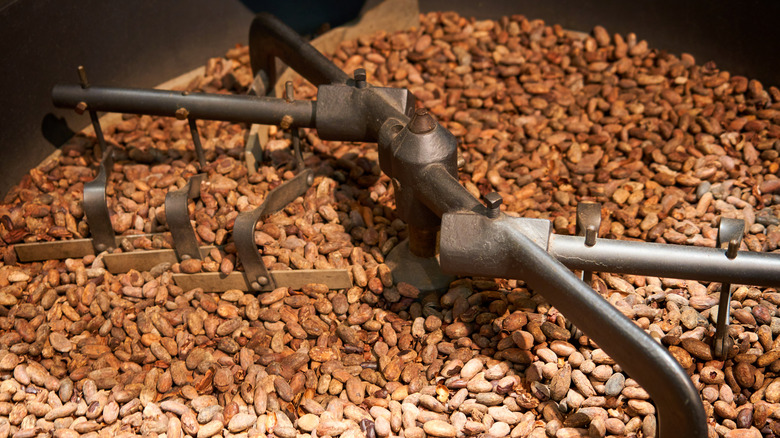The Science Behind Why Dark Chocolate Is So Bitter
Once used as offerings to the gods and as a form of currency by the Olmecs, Mayans, and Aztecs, cacao beans have taken on a different value in modern society. Today, these beans are the basis of all the chocolate we love so much, but it has taken centuries for chocolate to become the ubiquitous treat we know it as.
In the time when the Mayans drank cacao beans in liquid form, they were considered savory, with the beans being ground with maize and mixed with water. Considering chocolate contains many chemical compounds with a distinctly bitter taste, it's not all that surprising that the Mayans didn't initially think to use cacao as the basis of what we now think of as a go-to dessert ingredient. This changed fairly quickly however, with sugar and spices ultimately being added to the mixture to make it more pleasing.
Since then, the way chocolate is prepared has changed significantly, but the practice of adding sugar to balance out the inherent bitterness has remained the same. Even the dark chocolate, while much more bitter than milk chocolate, is still typically balanced with some sort of sweetener. But what exactly makes the cacao beans so bitter in the first place? Here's everything you need to know about the bitterness of dark chocolate.
Chocolate is made using processed cacao beans
To understand what gives chocolate its inherent bitterness, it's helpful to understand just how it's made. Cacao beans come from the Theobroma cacao tree, on which large fruits grow. These pod-like fruits contain between 20 and 60 beans each and it's these beans — which are fermented, dried, roasted, and ground — that are used to make chocolate. Processed cacao beans are used to produce two main components: cocoa solids and cocoa butter. Cocoa butter is the fat and is used by itself to make white chocolate. The butter doesn't affect overall flavor, but cocoa solids are what gives the chocolate its color and flavor.
After the cacao beans have been processed, other ingredients are mixed with the cocoa solids and butter, and this is where the main difference between milk chocolate and dark chocolate emerges. Typically, the processed cacao beans are mixed with some combination of sugar, emulsifiers, aroma, and milk before the mixture goes through conching and tempering. But the amount of extra ingredients used is what separates dark chocolate from other types.
More cocoa in dark chocolate means more bitterness
We all have our own preferences when it comes to chocolate, with milk chocolate being by far the most popular. But many prefer a more robust and slightly more bitter form of this beloved treat, and that's where dark chocolate comes in. This form of chocolate is designed to highlight the natural bitterness of cocoa, which is achieved in part by using more cocoa solids in the mixture. These solids contain the essence of the cacao bean and are packed with flavonols, a type of antioxidant plant compound. The flavanols contain much of chocolate's innate bitterness, and since dark chocolate uses more cocoa solids, and therefore more flavanols, it has less room for sugar, making for a distinctly bitter taste.
Typically, dark chocolate is made of just cocoa mass and cocoa butter which is balanced by sugar. No milk is used in the production of dark chocolate, which will usually have a cocoa level of 70%, which means that 70% of the chocolate is made using ingredients solely from the original cacao bean, while 30% is added ingredients (usually just sugar), but some dark chocolate can go all the way to 99%, making for an even more intense bitterness.
Chocolate has plenty of bitter chemical compounds
Chocolate actually contains hundreds of chemical compounds, many of which give off a bitter taste — an adaptation that deters herbivores and frugivores from eating the seeds in the wild. Theobromine, for example, is a bitter chemical, small amounts of which are found in cacao. Theobromine has a very similar molecular structure to caffeine and affects the human body in similar ways such as widening blood vessels and acting as a stimulant. Caffeine can also be found in chocolate, which as any coffee drinker will know, has a very bitter taste.
Another compound with an inherently bitter taste found in chocolate is phenylethylamine, which also has stimulating effects. Alkaloids and polyphenols in cacao beans are also generally quite bitter and alongside the bitter salts inherent in chocolate, such as magnesium, potassium, calcium, and iron, all add up to a very sharp and striking bitter flavor that is naturally present in the cacao plant, and therefore finds its way into the final chocolate product — especially dark chocolate.
Cacao pod type and preparation play a role in dark chocolate bitterness
The fundamental bitterness of chocolate comes from the cacao plant itself and the various chemical compounds contained in the fruit. But, there are other factors that play into the bitterness of dark chocolate.
For one thing, certain cultivars of cacao beans are naturally more bitter than others. Cacao beans vary in many ways, from aroma and color to size and flavor. The Forastero beans grown in equatorial Africa have a generally stronger flavor, a more bitter taste, and are the most widespread form of cacao beans. Criollo beans, however, are more aromatic and sweeter. Grown in South American countries such as Colombia, Peru, and Venezuela, these beans have notes of honey and red berries. There are even hybrid beans, which combine elements of both. As such, the type of bean used in chocolate production can have a significant impact on the overall bitterness of the final product.
Another factor that plays a big role in dark chocolate bitterness is preparation. There are steps chocolatiers take during the preparation process, such as roasting the cacao beans for longer and at higher temperatures, that further enhance the bitter flavors found in dark chocolate.
While the fermentation process is typically the same for milk and dark chocolate, it is worth noting that this process can also contribute to bitterness. Fermentation is an important stage that brings out more complex flavors in the cacao beans, taking them from raw and bitter to flavorful and rich. Shorter fermentation times lead to a more bitter taste but this isn't typically a method of making dark chocolate more bitter in the way that roasting and using cocoa solids are.




